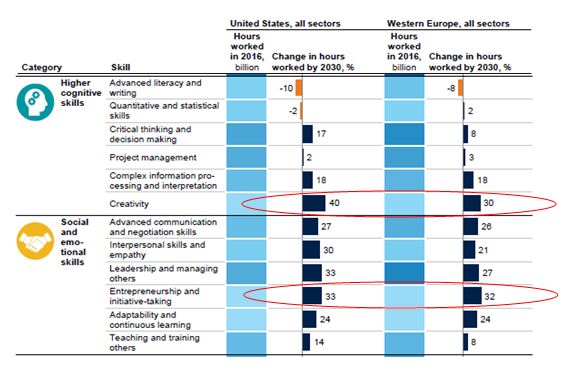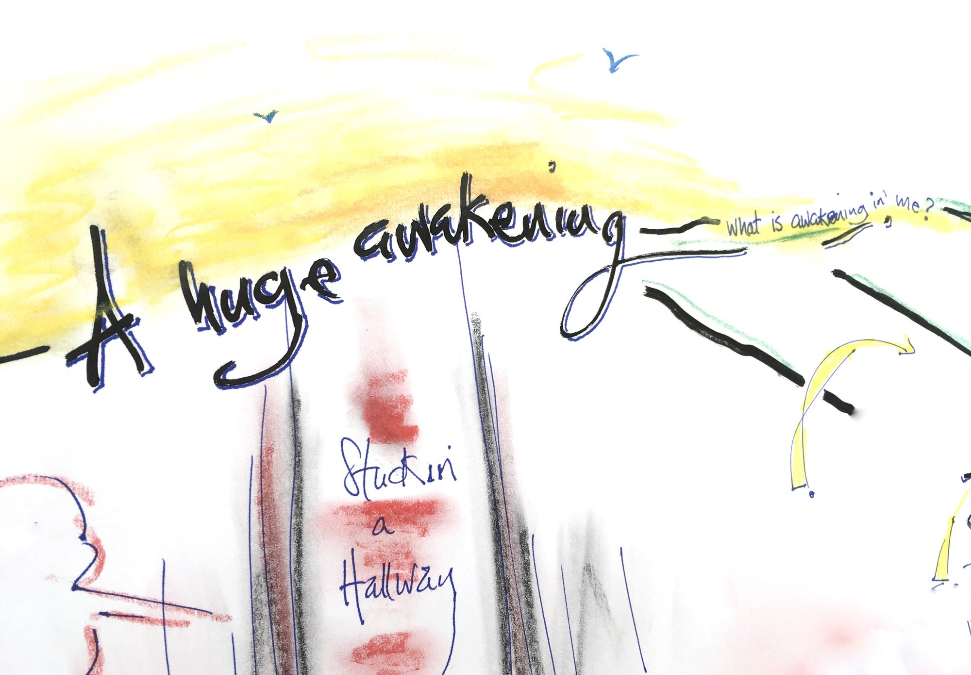CONTEXT
There was a time when completing a degree or certificate (also known as a “Hard Skill”), like speaking a foreign language, typing 80 words / minute, operating a machine or programming computers, was sufficient to find good employment and earn a decent living. Although it wasn’t that long ago, when EMPLOYABILITY was synonymous to having a degree, it certainly does seem that way.
In today’s world, the workplace not only demands that we master a Hard Skill, it also expects us to have impeccable social skills (known as “Soft Skills”). In fact, most jobs attribute at least as much importance to communication, flexibility, motivation, persuasion, problem solving abilities, teamwork, time management and work ethic as it does to hard skills. Given the hyper connected / competitive world we live in, this makes sense. Innovation, speed to market, trustworthiness, customer centricity are no longer a nice to have, they are now a MUST for any organization to survive. Without highly evolved soft skills our ability to collaborate on projects, earn the trust of stakeholders and listen deeply to the needs of the marketplace will be limited. So EMPLOYABILITY in today’s world is very much a function of how well we master both hard AND soft skills.
This much is clear and most organizations, as well as some of the more progressive educational institutions, recognize it and have invested significantly in building the soft skill competencies of their employees. With the advent of AI (artificial intelligence), advanced robotics and other exponential technologies, the big question on people’s mind now is what will the FUTURE OF WORK look like in this new environment. What new competencies will be needed, in addition to hard and soft skills?
Clearly competing with the productivity benefits of advanced technology is not a viable employability strategy going forward. We believe the future of work will require human beings to express more of their innate creativity in order to imagine new solutions for the grand challenges we face as a society (climate change, population growth, income inequality…). At least in the short and medium term, this is not something that technology will be able to do for us.
A recent McKinsey study supports this vision. It concludes that Creativity and Entrepreneurship will see the biggest % increase in hours worked between now and 2030 (40% and 33% respectively).

Other experts, like NYU Professor Richard Sennett, advocate that the future of work is about how well a person hones in on their own craft and becomes better at it than 99% of the population. Craftsmanship, he says, is an “enduring basic human impulse, the desire to do a job well for its own sake.” Whether you’re a coder, customer sales rep, surgeon, or lawyer, your work is craft, and if you hone your ability and apply it with respect and care, you can generate meaning in the daily efforts of your professional life.
Therefore, creativity, entrepreneurship, craftsmanship and meaning, will be the buzzwords of the future. This is not only what will be expected from employees going forward, it’s also what the younger generation of more conscious leaders will demand! EMPLOYABILITY in the future will require us to go beyond hard and soft skills. Ultimately, it will be all about expressing and unleashing HUMAN POTENTIAL. In other words, we will need to look deep inside ourselves and connect with the creativity and passion that fuels our unique craft and inspires greatness. Only this will unleash the next wave of value creation for organizations while at the same time providing a deep sense of meaning for the individual.
The following diagram illustrates how the Future of Work will require a “whole-person” approach to Employability. By integrating our hard and soft skills with the innate sense of purpose that lies inside each one of us, it will be possible to unlock vast amounts of underutilized Human Potential, access creative breakthroughs and turn a simple job into a meaningful craft.

SOLUTIONS:
Our unique Future of Work and Employability assessment for policy makers and organizational leaders is a holistic tool to measure all the key levers that will enable success of the future workforce. The output of this 83 question survey includes:
- Employability Index: a robust assessment of how well a person will perform in today’s environment. This index takes into account:
- A person’s hard skill qualifications which determine the depth and breadth of work that he or she can take on at a certain point in time.
- A person’s ability to master the 10 most important soft skills (what we refer to as behaviour skills).
- Future of Work Index: a robust assessment of how well a person will perform in the future environment. This index takes into account:
- The extent to which a person embraces what we refer to as the 8 Being Attitudes. These are the attitudes or mindsets that we must adopt in order to fully access the inner resourcefulness that lies within each one of us.
- As well as the hard and soft skills as outlined above.
- Personal Performance Metrics: a robust assessment of how the combination of a person’s hard skills, soft skills and Being Attitudes will determine their ability to impact the five Professional Performance Measures (ie: the five key priorities for employers (PPMs): Trustworthiness, Getting Things Done, Inventiveness, Personal Engagement and Stakeholder Orientation) as illustrated in the “Future of Work” wheel below. The 8 Being Attitudes are at the core of the wheel, the 10 soft skills or behaviour skills in the middle and the Personal Performance Metrics on the outer circle.
The 8 Being Attitudes are at the core of the wheel, the 10 soft skills or behaviour skills in the middle and the Personal Performance Metrics on the outer circle.

FEATURES AND BENEFITS OF OUR “EMPLOYABILITY + FUTURE OF WORK” SOLUTION:
- We shift the focus back to core of people’s innate potential and not jobs.[1] The Human Potential Employability + Future of Work assessment is not just an idea or an intellectual theory, but it is practical, actionable and experiential developmental process. It is an advanced, well- tested solution delivered by Human Potential facilitator and coach.
- We offer state-of-art learning and developmental solution that lies at the intersection of cutting edge of cognitive-development-psychological science and ancient wisdom traditions. “No problems can be solved from the same level of consciousness created it.”[2] We develop people to shift mindset to a next level of consciousness and self-awareness (or self-identity) to solve and adapt to problems, challenges and opportunities in the future of work.
- Edward Deeming famously said that “In God we trust, all others bring data.” Our Employability Assessment and developmental tool puts a wealth of 23 Human Potential data-points and tangible “facts” on the table to help millenials and Gen Z youths coming into the workforce to be able to stay focused, engaged and inspired to participate fully in meaningful and new conversations (head-heart-spirit) at the workshop discussions.
- Our solution is transformational in practice, a rarer form of development that entails a more complete transformation in the individual’s meaning making and in their overall view of reality that in turn transform what they think, how the feel and what they do.[3] This is sustainable and contributes in time to life-long benefits in personal development, wellbeing and happiness. It is ‘learning-to-Be’ beyond ‘teaching to do’.
- Self realization (not self preservation) is now the primary motivation to work and driver of business performance in the future of work. This translates to increased employability capabilities through measures of personal engagement (self-agency), inventiveness, trustworthiness, stakeholder orientation and getting things done (refer to ‘Employability Wheel’ on page 4).
- It is a “win-win-win” for young people seeking a job, the employers and the policy makers and leaders. As mentioned above, ultimately, it pays breakthrough dividends to the overall wellbeing of people in organisations, society and the nation overall.
APPENDIX
Vertical Learning is the key to shift the Employability mindset to the next level of consciousness or self-awareness
According to the constructive-developmental scientists and researchers, there are two kinds of growth that we associate with adult development – vertical and horizontal and both are important, but they are very different. “If horizontal development is concerned with content and what we know, vertical development is concerned with how we know it (Harris & Kuhnert). As Cook-Greuter describes it, horizontal development is the gradual accumulation of new knowledge, new skills and experience, which can occur without any fundamental change in the individual’s overall meaning making, epistemology or worldview. Vertical development on the other hand, which is a much rarer form of development, entails a complete transformation in the individual’s meaning-making and in their overall view of reality that in turn transforms what they think, how they feel and what they do.”[4]

[1] Inspires by PWC’s report – “Workforce of the Future – The competing forces shaping 2030” – page 5; italics mine
[2] Quote is attributed to Albert Einstein.
[3] Reference – from Cook-Greuter research and her work.
[4] Edward Kelly – Transformation in Leadership, Part 1: A Developmental Study of Warren Buffett

